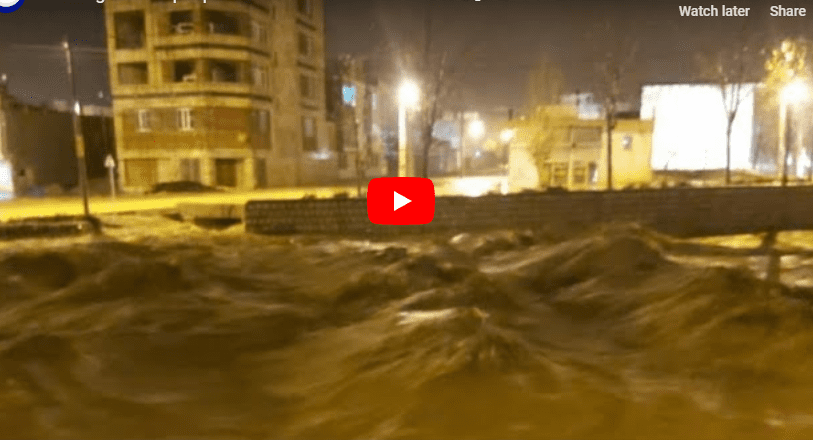Authorities warned residents in the western province of Lorestan to evacuate their homes as heavy rainfalls caused flooding in some towns. Some 37 villages were inaccessible and some 100 villages were cut off from the power grid.
Iran is entering its rainy season. Record rainfalls at this time last year caused flash flooding, leading to over 77 deaths and almost 800 injured. An estimated $2 billion of damage was reported. The severity of the floods was greatly increased due to the conversion of flood routes and dry river beds for urban development without providing proper drainage infrastructure. Over two million people were affected by the floods.
While western Iran is coping with floods, southern Iran is bracing for an infestation of locusts. The swarms are rampaging across Africa, taking on Biblical proportions that have not been seen in several decades. Many populations already suffering from food shortages are being hard hit. The swarm is spreading and is already at the border of China and now threaten Iran as well.
According to the official IRNA news agency, Mohammad Reza Dargahi, the head of the Plant Protection Organization of Iran, has also warned that failure in controlling the locusts will jeopardize billions of dollars of Iranian agricultural products.
Mohammad Reza Mir, the agricultural expert in the Plant Protection Organization of Iran, acknowledged that an infestation is imminent but denied that it was a significant threat.
“We are well equipped and prepared to fight these pests,” Mir said, adding that pesticides have been adequately supplied.
These natural catastrophes come in the wake of a Magnitude 5.7 earthquake struck the Turkey-Iran border region early Sunday. The earthquake was followed by three aftershocks between magnitude-4.1 and magnitude-4.4 and eleven hours later by an even larger 6.0 aftershock. The earthquake was widely felt in Iran and 51 people were reportedly injured in the quake. Iranian officials haven’t reported any deaths yet.
Iran and Turkey sit on top of a major fault line between the Arabian and Eurasian tectonic plates and are among the most earthquake-prone countries in the world.
In November 2017 a 7.3-magnitude tremor in the western province of Kermanshah, Iran killed 620 people. In 2003, a 6.6-magnitude quake in southeast Iran decimated the ancient mud-brick city of Bam and killed at least 31,000 people. It did not damage the nearby plant. Iran’s deadliest quake was a 7.4-magnitude tremor in 1990 that killed 40,000 people in northern Iran, injured 300,000 and left half a million homeless.
Many of these earthquakes are in the Bushehr province in which Iran’s nuclear power plant is located, the most recent in January.
Iran is the hardest-hit country by the coronavirus outside of China, with the government announcing that 12 people had died from the virus and an additional 61 infections had been diagnosed.
The pandemic in Iran has focused on the holy Shia city of Qom. Iranian officials are blaming travelers from China for the spread of the disease.
But these data have been questioned. The Guardian and AFP cited the semi-official ILNA news agency that reported the claims of Ahmad Amirabadi Farahani, a government official from the city of Qom, as saying that at least 50 people have died in that city alone. Farahani claimed that 250 people are quarantined in the city.
Pakistan, Turkey, Azerbaijan, Armenia have either partially or entirely closed their borders to Iran and at least one crossing point with Kuwait was closed. On Sunday, Pakistan and Turkey closed their borders with Iran due to the rapid spread of the coronavirus in the Islamic Republic and the unwillingness of Iranian leaders to be clear on the extent of the threat. Iraq had already conducted some border closures and bans on Iranians traveling to the country. Afghanistan and Armenia also closed their borders with Iran.
It should be noted that all these woes are appearing as the Jews enter the Hebrew month of Adar in which the holiday of Purim is celebrated. Purim commemorates the victory of the Jews over Haman, an Achaemenid Persian Empire official who was planning to kill all the Jews, as recounted in the Book of Esther. The event is usually dated to the 4th century BCE.
A Breaking Israel News report last month described how the U.S. drone strike that killed Gen. Qasem Soleimani and ten of his cohorts left behind little to identify his body. Soleimani’s death was confirmed by the remains of his arm, still wearing a large red ring he never removed. Haman was also noted for wearing the king’s signet ring.
Thereupon the king removed his signet ring from his hand and gave it to Haman son of Hammedatha the Agagite, the foe of the Yehudim. Esther 3:10
The Book of Esther culminates in Haman being hanged along with his ten sons, and the Jews successfully defending themselves against their Persian enemies.
https://www.youtube.com/watch?v=E6MlJSW5-qo&feature=share&fbclid=IwAR3ASbvMjONP_6_xQCOPAEjY77Ea49xy1yNP8Dblo248cpAPbPkH800-O2Y




